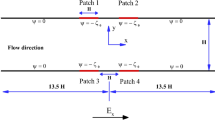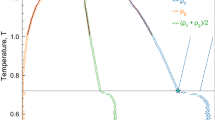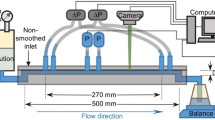Abstract
Mixing in fluids is a rapidly developing area in fluid mechanics1,2,3, being an important industrial and environmental problem. The mixing of liquids at low Reynolds numbers is usually quite weak in simple flows, and it requires special devices to be efficient. Recently, the problem of mixing was solved analytically for a simple case of random flow, known as the Batchelor regime4,5,6,7,8. Here we demonstrate experimentally that very viscous liquids containing a small amount of high-molecular-weight polymers can be mixed quite efficiently at very low Reynolds numbers, for a simple flow in a curved channel. A polymer concentration of only 0.001% suffices. The presence of the polymers leads to an elastic instability9 and to irregular flow10, with velocity spectra corresponding to the Batchelor regime4,5,6,7,8. Our detailed observations of the mixing in this regime enable us to confirm several important theoretical predictions: the probability distributions of the concentration exhibit exponential tails6,8, moments of the distribution decay exponentially along the flow8, and the spatial correlation function of concentration decays logarithmically.
This is a preview of subscription content, access via your institution
Access options
Subscribe to this journal
Receive 51 print issues and online access
$199.00 per year
only $3.90 per issue
Buy this article
- Purchase on Springer Link
- Instant access to full article PDF
Prices may be subject to local taxes which are calculated during checkout





Similar content being viewed by others
References
Sreenivasan, K. R., Ramshankar, R. & Meneveau, C. Mixing, entrainment, and fractal dimension of interfaces in turbulent flows. Proc. R. Soc. Lond. 421, 79–108 (1989).
Shraiman, B. I. & Siggia, E. D. Scalar turbulence. Nature 405, 639–545 (2000).
Warhaft, Z. Passive scalars in turbulent flows. Annu. Rev. Fluid Mech. 32, 203–240 (2000).
Batchelor, G. K. Small scale variation of convected quantities like temperature in turbulent fluid. J. Fluid Mech. 5, 113–133 (1959).
Kraichnan, R. H. Convection of a passive scalar by a quasi-uniform random straining field. J. Fluid Mech. 64, 737–762 (1974).
Chertkov, M., Falkovich, G., Kolokolov, I. & Lebedev, V. Statistics of a passive scalar advected by a large scale 2-dimensional velocity field—analytic solution. Phys. Rev. E 51, 5609–5627 (1995).
Shraiman, B. I. & Siggia, E. D. Lagrangian path integrals and fluctuations in random flow. Phys. Rev. E 49, 2912–2927 (1994).
Balkovsky, E. & Fouxon, A. Universal long-time properties of Lagrangian statistics in the Batchelor regime and their application to the passive scalar problem. Phys. Rev. E 60, 4164–4174 (1999).
Larson, R. G., Shaqfeh, E. S. G. & Muller, S. J. A purely viscoelastic instability in Taylor-Couette flow. J. Fluid Mech. 218, 573–600 (1990).
Groisman, A. & Steinberg, V. Elastic turbulence in a polymer solution flow. Nature 405, 53–55 (2000).
Bird, R. B., Curtiss, C. F., Armstrong, R. C. & Hassager, O. Dynamics of Polymeric Liquids (Wiley, New York, 1987).
Byars, J. A., Öztekin, A., Brown, R. A. & McKinley, G. H. Spiral instabilities in the flow of highly elastic fluids between rotating parallel disks. J. Fluid Mech. 271, 173–218 (1994).
Joo, J. L. & Shaqfeh, E. S. G. Observations of purely elastic instabilities in the Taylor-Dean flow of a Boger fluid. J. Fluid Mech. 262, 27–73 (1994).
Miller, P. L. & Dimotakis, P. E. Measurements of scalar power spectra in high Schmidt number turbulent jets. J. Fluid Mech. 308, 129–146 (1996).
Williams, B. S., Marteau, D. & Gollub, J. P. Mixing of a passive scalar in magnetically forced two-dimensional turbulence. Phys. Fluids 9, 2061–2080 (1997).
Acknowledgements
We thank G. Falkovich for theoretical guidance and discussions. The work was partially supported by the Minerva Center for Nonlinear Physics of Complex Systems, by a Research Grant from the Henry Gutwirth Fund and by an Israel Science Foundation grant.
Author information
Authors and Affiliations
Corresponding author
Rights and permissions
About this article
Cite this article
Groisman, A., Steinberg, V. Efficient mixing at low Reynolds numbers using polymer additives. Nature 410, 905–908 (2001). https://doi.org/10.1038/35073524
Received:
Accepted:
Issue Date:
DOI: https://doi.org/10.1038/35073524
This article is cited by
-
Mixing in Porous Media: Concepts and Approaches Across Scales
Transport in Porous Media (2023)
-
Controlling collective rotational patterns of magnetic rotors
Nature Communications (2019)
-
Elastic Alfven waves in elastic turbulence
Nature Communications (2019)
-
Vortex generation by viscoelastic sheath flow in flow-focusing microchannel
Korean Journal of Chemical Engineering (2019)
-
On the role of initial velocities in pair dispersion in a microfluidic chaotic flow
Nature Communications (2017)
Comments
By submitting a comment you agree to abide by our Terms and Community Guidelines. If you find something abusive or that does not comply with our terms or guidelines please flag it as inappropriate.



